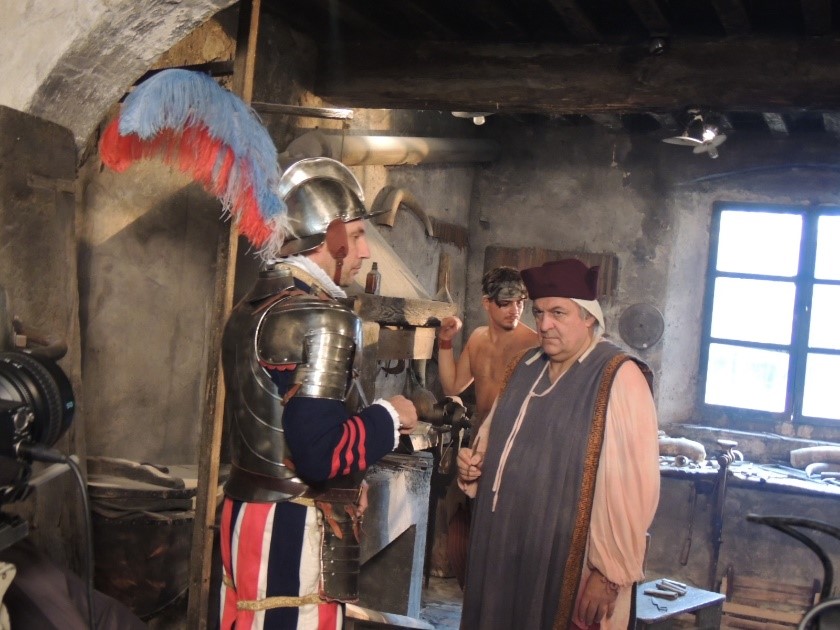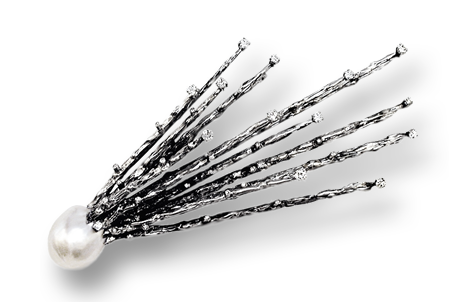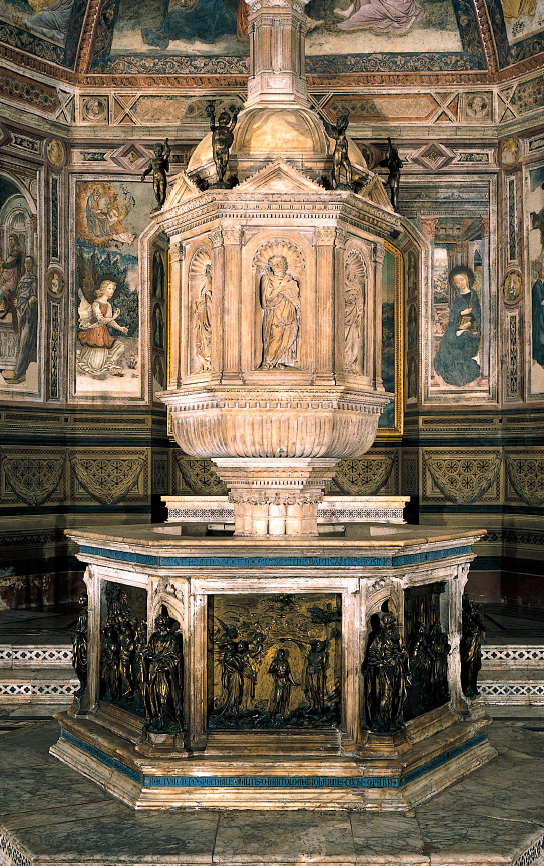Scraps of History of the
Torrini Goldsmith Lineage
(The data and historical references highlighted here bring out the most representative historical figures in the long history of the Torrini Goldsmith Lineage
and are taken from the research preserved in the Torrini 1369 Historical Archive, protected according to legal constraints.)

The workshop of the armor manufacturer
14th CENTURY IN SIENA
Tura, perhaps at the same time moved to Siena, for this reason called Tura da Vignano, to collaborate with his art in the construction of some details of the Duomo. He works in a shop in the center of the city, carrying out his activity with great skill, having all his mastery in all the techniques then known. He passed on the secrets of his trade to his children and to the pupils who followed him.
In Siena Tura and his descendants, the Turini, were recipients of great attention. The commissions and cultural meetings accumulated and multiplied; they collaborated with numerous artists, leaving their magnificent masterpieces that enriched the city.
In addition to their activity as goldsmiths, in their workshop they also experimented with enamel and niello; they carved stone and wood for interior decoration and created magnificent polychrome wood sculptures that can still be admired in Montalcino, Sant'Ansano and Siena.
From the son Sano in 1355 was born Turino, celebrated goldsmith in Siena, from him 8 sons including Giovanni e Lorenzo, goldsmiths as precursor members of what later became the Turini Goldsmith Lineage. With their specificity and ability, they also competed with Florentine artists and played an active and important role in the evolution of the goldsmith's art in Tuscany
14th CENTURY IN SCARPERIA
We are in the first half of the 1300s and this narrative is linked to a sign. The whole story started from a fundamental fact:
Jacopus Turini registers his trademark, the Signum, to the Guild of Fabbri and Corrazzai of Florence.
It is the year 1369.
In fact, in order to regulate the artisan activities of the surroundings of the city that come into contact with foreigners passing through the Republic of Florence, registration with one's trademark at the belonging Guild is required, which in the case of Jacopus was also the one that cost less than other much richer Arts. Thrift came to light in a time of great widespread poverty.
Jacopus comes from the small village of Battiloro, close to Parish church of San Giovanni Maggiore, an agglomeration of houses near Borgo S. Lorenzo, where since the early 1300s, with his father Bernardo and his brother Tura, in fact the three founders of the Lineage, had worked all metals with great skill and the precious gold by reducing it to leaves.
Jacopus lived in 1356 in the district of S. Giovanni in Scarperia and is estimated at Lire 4 and 15 soldi. (A.S.F. Estimate 282 -1356).

Jacopus open his new workshop in Scarperia and produces armours and cuirasses for the knights that pass along the trans Apennine road of the “Giogo” to reach Florence. Are times when armors is valuable because these artifacts ensure the defense. The artisans of armors and weapons are among the most sought after and Jacopus, in addition to the protection functions for which they are used, also addressed a lot of attention to aesthetics, to the creation of extraordinary works of art.
The "Signum", that is the trade-mark, is the unquestioned link that confirms this Lineage’s long tradition as goldsmiths.
The Torrini Goldsmith Lineage has been handed down from father to son for more than six centuries, almost unwittingly, giving to the trade-mark, the lucky auspicious significance of the half a four-leafed clover with a spur.
It is assumed by some indirect written, but there is no documentation, which also Jacopus towards the end of the XIV century joined his brother Tura in Siena, thus giving life to the familiar branch that created a fascinating human journey.

15th - 16th CENTURY
Giovanni di Turino (1400 - 1455) alias Giovanni Turini
Giovanni Turini was not only the strongest artistic personality of the workshop, since he knew and practiced many techniques with great versatility but in the first half of the fourteenth century he was also the most representative figure of the goldsmith's art in Siena as Vasari wrote in his Comment on life of Pollaiolo.
The Baptismal Font of the Baptistery of Siena (it is the masterpiece in which Giovanni's bronze reliefs, made together with his father Turino, make a good impression next to those made by the greatest artists of the time, such as Jacopo della Quercia, Donatello and Ghiberti with whom he was a sincere friend.
The history of the family testifies that its members during the fifteenth century held the prestigious position of Prior of Siena 28 times, thus acquiring the title of "Nobles of Siena".
Following the wars between the Guelphs and Ghibellines, the Turini fled from Siena and returned in the second half of 1500 to their native land in the Mugello region near Florence, mainly in the villages of Borgo San Lorenzo and Scarperia, thus reuniting the family lineage and transforming, little to the once, the patronymic surname Turini in Torrini as we know it today.
In 1600 a branch moved to the region of Umbria while some documents give us the historical certainty that the family stock continued the activity in Mugello and Florence.
17th - 18th CENTURY IN FLORENCE
Francesco Torrini (c. 1676-1735)
Information was found on the goldsmith's workshop of Francesco Torrini, whose registration document in the Art of Silk of 13 November 1700 has been preserved until today in the State Archives of Florence. We also discovered that Maestro Francesco ran a shop on the Ponte Vecchio in 1703.
Of its production, only 8 brooches have been found which constitute a certain rarity because in that period, to follow the fashion, the disassembly and reassembly of jewels becomes very frequent and constitutes the main reason for the dispersion of jewels of which remain, in the most cases lucky, just graphic examples.
Classical art has been overcome by events, even Francesco Torrini's production is influenced by it: as we see his brooches are refined, delicate, light and asymmetrical jewels bouquets of flowers tied by ribbons in which diamonds take over the setting.
Despite their splendor, these brooches, however, maintain a typically Florentine constant unchanged: a certain sobriety and austerity even in this era of whimsical imagination. It is not easy to explain the causes, perhaps it could be the attention that Francesco always maintains for patient craftsmanship or because this art, like others in Florence, closely follows the events of the political fortune of the city that reduce worldly occasions. to exhibit such jewels.
The "Jug" which is dated to the end of the seventeenth century and the beginning of the eighteenth century is sure of him by him due to the Torrini trademark affixed there and for the coincident period of activity.
19TH CENTURY IN FLORENCE
Giocondo Torrini (1827 -1896 ca.)
In the 1841 census kept in the State Archives of Florence, in the sheets concerning the population of the Parish of S. Salvatore d'Ognissanti we find news of another representative of the Torrini Goldsmith Lineage: Giocondo Torrini, born in 1827. Giocondo had his shop on the Lungarno Nuovo 6 red in Florence, in the center of the quadrilateral dedicated to the Grand Tour and with his skill combined with a rare commercial skill achieved respectable international fame by presenting himself at the European Universal Expositions with great public success. The European International Exhibitions of the second half of the 19th century put Giocondo Torrini in direct comparison with French and English fashion, who promptly received the aesthetic messages, cultural references and new stimuli for renewal that were being codified in the decorative arts.
His activity is documented through numerous mentions and awards traced in the catalogs of the Exhibitions and the existence of some jewels such as the refined set, preserved in the British Museum in London, consisting of brooch and earrings with Florentine mosaic plaques depicting Pliny's doves.
20th CENTURY
Guido Torrini (1896 - 1968)
In 1919 he began his activity as a goldsmith in the workshop in Piazza S. Trinita in Florence; he then opens shops in Chianciano Terme, Chiusi and Taormina. He acquires a substantial stake in the then existing jewelry shop in Piazza Duomo in Florence.
He makes deco-style jewels, objets d'art in semi-precious stones enriched with gold parts and, a great lover of watchmaking, produces around 1931. the first Torrini branded pocket watch.
In 1945, returning from Dachau, the terrifying German concentration camp, where in 1943 he had been political deportation, he tenaciously reconstructs his activity which was completely destroyed by the war.
In 1946 the shop in Chianciano Terme reopened, a spa town of great prestige after the war and in 1948 the ancient factory reopened in Florence a few steps from where it was previously located, in Chiasso del Buco, next to Via Por Santa Maria totally destroyed by Germans mines in 1944.
In 1962 Guido, making use of his dated shareholding, took over the entire jewelery shop in Piazza Duomo 12 / R in Florence. entrusting its management to his son Franco.
He continues his activities in the Chianciano Terme shop, wich he opened in 1921, until his death.
21th CENTURY IN FLORENCE
Franco Torrini (1934)
The story of the Torrini 1369 Trademark continues with Franco, Guido's son, who after completing his studies in watchmaking in Geneva, devotes himself to the study of gemology and goldsmithing, absorbing the art from his father and the goldsmith masters who alternate over the years at the Goldsmith factory of his family.
In 1962 he took over the management of the historic shop in Piazza Duomo.
He also expresses his creativity in other artistic forms such as painting and sculpture, stimulated in the seventies by frequenting numerous contemporary artists. Survival was once again put to the test with the 1966 flood in the historic shop in Piazza Duomo in Florence.
In 1969 he registered the old trademark at the Italian Patent and Trademark Office in the modern era.
In 1978 he opens a Franchise Shop in the heart of London, in Old Bond Street, then a store in New York in the then famous Bonwit Teller department store and in Tokyo.
In 2009 with final effect in 2011 of the previous license, Franco personally reacquired the full ownership and availability of the Torrini 1369 figurative trademark and the trade name with the termination of the 1977 contract.
Franco then gives life to a personal entity such as the Historical Archive Torrini 1369 with the task of preserving, defending and promoting, on a non-profit basis, the history of the Torrini 1369 figurative trademark.
In 2012 Franco offers, under equal rights to both sons, the signing of the license to use the figurative trademark Torrini 1369 and tradename (Classe 14), including all historic representative and commercial effects.
The license was signed by the daughter Francesca, owner with her son Guido of the Torrini 1369 Historic Shop in Piazza Duomo in Florence. This license for use is then amended and better specified in 2020 and 2023, following historical and commercial investigations and in order to exclude any possible deceptive use of the trademark itself.
The history of the Torrini 1369 trademark, therefore, becomes the future.
(Historical research up to the 19th century by Laura Bresciani,
Curator of the Torrini 1369 Historical Archive)

Giocondo Torrini. 19th Century British Museum

Guido Torrini. Gold and enamel box







